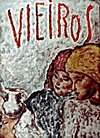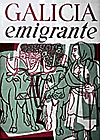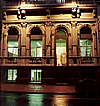Galician in the world
 It was the thousands of men and women who had to leave their land either for economic or labour reasons or for political reasons who laid the foundation of what Galician is now in the world. This diaspora had several phases. The first was in the nineteenth century, when thousands of Galicians left their homes to work as day labourers in Andalusia, Castile and Portugal. It was the thousands of men and women who had to leave their land either for economic or labour reasons or for political reasons who laid the foundation of what Galician is now in the world. This diaspora had several phases. The first was in the nineteenth century, when thousands of Galicians left their homes to work as day labourers in Andalusia, Castile and Portugal.
Between 1860 and 1936 most of the Galician exodus ended up in Cuba, Argentina and Brazil. This emigration was mostly of men who left behind their wives and children, "the widows of the living and the widows of the dead" in the words of Rosalía de Castro. It has been calculated that over half a million people left Galicia during this period. After the Civil War emigration was not permitted for several years -except for political exiles- but in the fifties emigration to Argentina started up again as well
as to Venezuela. At the same time emigrants started leaving Galicia for
Central Europe -the United Kingdom, France, Germany and Switzerland- and
the main industrial centres of Spain -Catalonia, the Basque country and Madrid-. This process slowed down at
the beginning of the seventies.
The cultural contribution of the Galician emigrants was not as great at
first as the strength of the Galician associations in the different South
American capitals with their mutual benefit and self-help approach.
 Their work was seen in the support given to the members of the "Irmandades" and in their contribution to the scientific work of the Seminar for Galician Studies. At the beginning of the century the Academia Galega was created in Cuba by Curros Enríquez among others. Their work was seen in the support given to the members of the "Irmandades" and in their contribution to the scientific work of the Seminar for Galician Studies. At the beginning of the century the Academia Galega was created in Cuba by Curros Enríquez among others.
With the arrival of the political exiles, cultural and political activity
increased in continuation of the work carried out in Galicia before the war.
These people received the open support of the emigrants who had been there
longer. Cultural societies were founded in several countries, especially
in South America and Mexico; the "Padroado da Cultura Galexa"
in Madrid was created in 1953 and became the centre for the promotion of
cultural activities. In Argentina the "Instituto Arxentino da Cultra
Galega" was created as well as the "Consello de Galiza" of
a political nature. Cultural production was most extensive -radio
programmes in Galician, lectures, books and journals were published, etc.
The publishing houses created by the emigrants made possible the publication
of their literary and research works, political essays, classical works...
Journals became one of the commonest means of communication in Galician
circles, as well as certain newspapers. The following are a few of the many
still existing: Galeuzka (1954, Buenos Aires), Vieiros (1959, Mexico) and Galiza Emigrante.
Argentina played the role of spiritual capital of Galicia. An enormous amount
of work was done there by such great men as Castelao, Blanco Amor, Luis
Seoane, Lorenzo Varela, Rafael Dieste, Lois Tobío. Castelao produced
his Os vellos non deben namorarse, the poetic works of Curros and Rosalía de Castro were re-edited and the Revista Nós and A Nosa Terra were kept going..
Radio was extensively used for the broadcasting of Galician cultural values and Galician thinking. In Montevideo on 3 September 1950 the programme Sempre en Galiza went on the air for the first time and continues today entirely in Galician. Luis Seoane promoted other programmes in Argentina but these could not be broadcast for legal reasons.
Emigration towards Europe started in massive quantities in the sixties to
meet the need for labour in the European countries.
Switzerland, the United
Kingdom and Germany were the main destinations of the Galician emigrants,
as well as Holland, Belgium and France.
Over the years many associations, "irmandades", and centres have
been created bringing together Galician emigrants. The basic objective of
these groups was to protect their members against the great difficulties
they had to face in a foreign environment. The list of Galician Centres
and Casas de Galicia open today in Europe would be interminable. Cultural
activities for emigrants receive support at present from Galicia by means
of various arrangements such as the Agreement with the Munich Children's
and Young People's Library, the presence at European Fairs and the above-mentioned agreements with the different universities and teaching centres.
Emigration within Spain was no less important although the numbers were
smaller. The many Centros Gallegos and Casas de Galicia throughout Spain
carry out notable cultural activities, constantly making known the Galician identity. |
|


Magazine published by "Padroado da Cultura de México" (Cultural
Association in Mexico).

Galicians in exile carried out political, cultural, and publishing activities.

Houses of Galicia and Galician associations kept our traditions alive.
 |